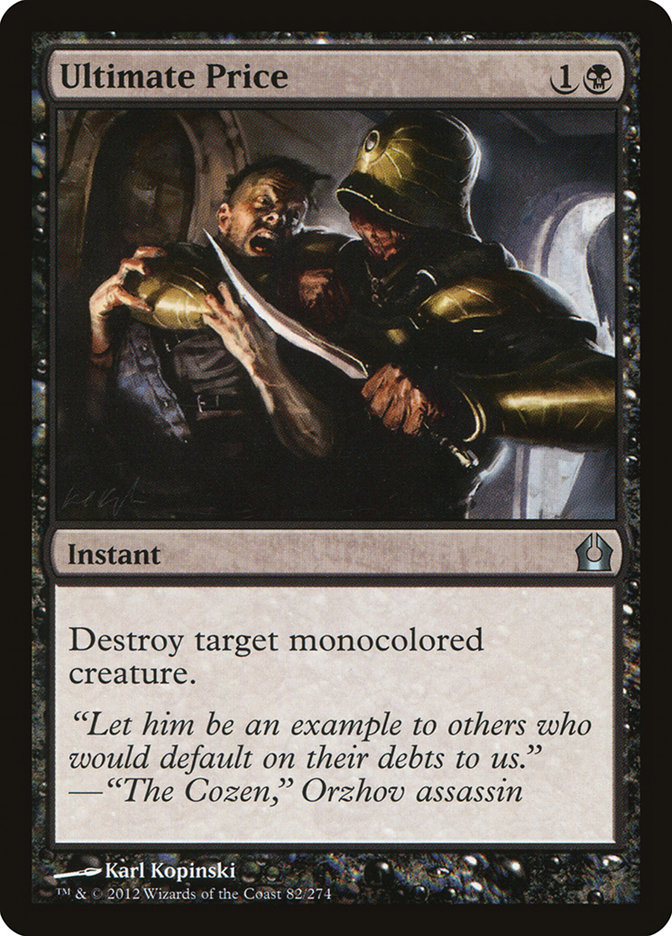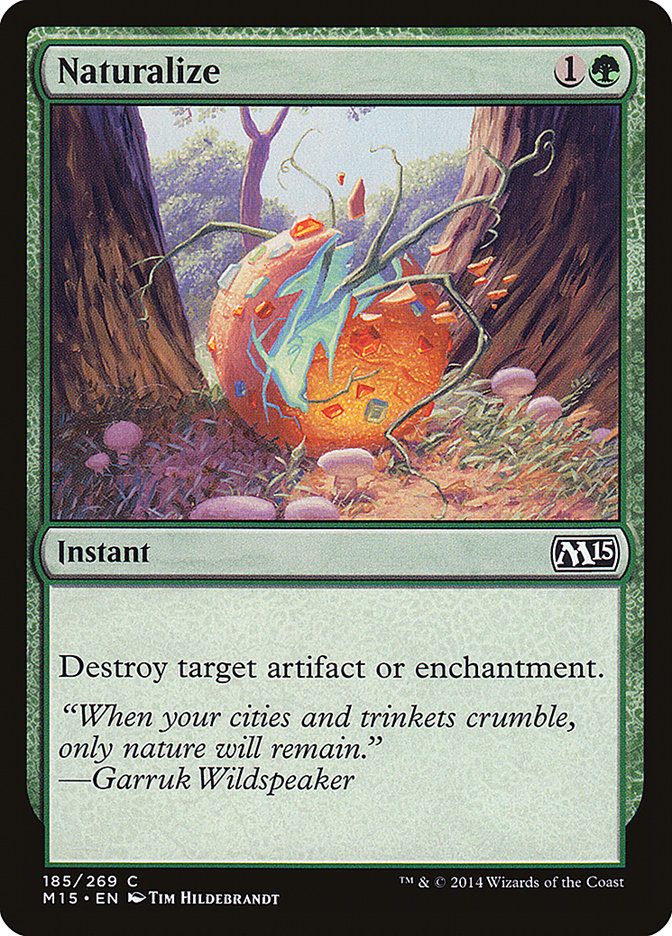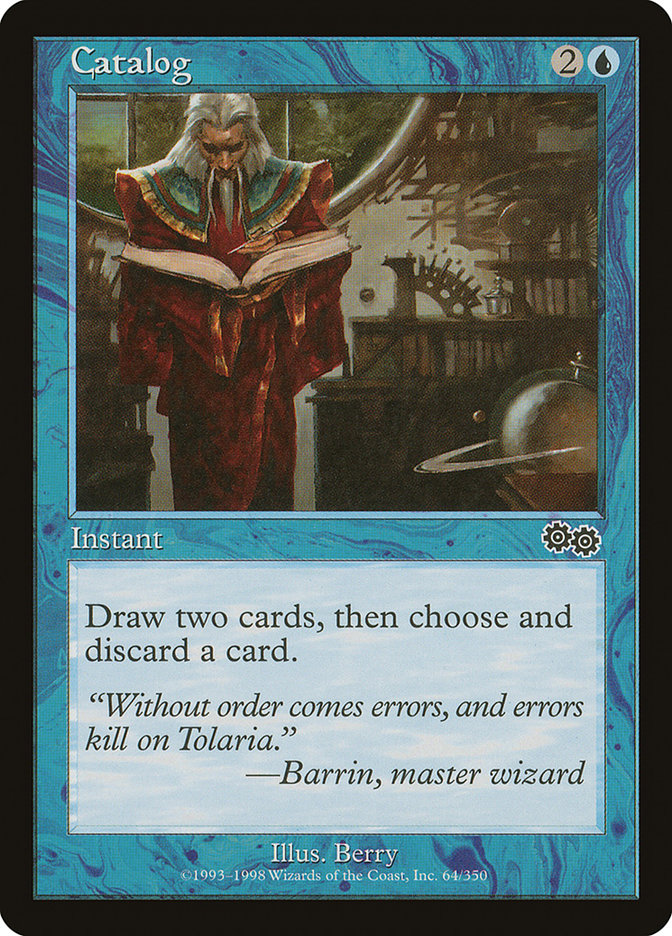Onslaught fetches!?!?
Yeah, of course.
What did you think they’d do?

Ban every card in Modern that involves shuffling? Don’t be silly. Obviously, that’s a whole lot of shuffling, but in Modern, everyone is already doing the
shuffling and loving it, and in Standard, there isn’t quite as much (and the searching part takes less time).
Fetchlands are definitely the sorts of cards that can really help define a format. Enemy painlands and Mana Confluence already mean players have access to
untapped duals if they are willing to pay the price. Fetchlands make that price much, much less. While fetchlands won’t be as insane as they are in Modern,
since they’ll only be fetching basics, they are still really strong.
It’s interesting just how many dual lands we have access to and the different pressures they put on the format. There is a lot of untapped dual land action
for those that value speed, but tri-lands and Temples are incredibly powerful tools for those that can afford to play it a little slower. Finding the right
balance is going to be an ongoing challenge.
Okay, so the five allied-colored fetchlands are in Khans of Tarkir. Which cards gain and or lose as a result? What are the strategic implications? How
might we actually use them in practice?
Well, the first card that jumps out at me that seems like not only the biggest gainer but an early candidate to be the defining card of the format…
Courser of Kruphix was one of the most dominant cards in block, being a defining pillar of that format. Remember, the new Standard format to come is just
Theros Block Constructed + M15 + Khans of Tarkir. As good as Courser was, that was nothing compared to what happens when it’s supercharged with fetchlands.
See, Courser of Kruphix is disgustingly powerful with fetchlands for a variety of reasons. To start with, Courser of Kruphix single-handedly negates the
fetchland life loss. In fact, you end up ahead, instead of behind! Courser of Kruphix makes you gain a life each time a land enters the battlefield under
your control, so Wooded Foothills gains a life for you, as does the basic you search up!
That’s already excellent synergy, but that’s not even the busted part. You know what works well with Courser of Kruphix? Ways to change the top of your
library. Fetchlands worked incredible with Oracle of Mul Daya, and Courser is a similar experience.
● Don’t want to draw the top card of your library? Shuffling from fetchlands effectively gives you a free loot. Having a bunch of fetchlands and a Courser
actually gives you a pretty intense amount of searching to find key cards from your deck.
● Don’t need to crack your fetchland yet? Don’t! Next turn, if the top card of your deck isn’t a land, and isn’t a card you really want on the following
turn, crack your fetch then. Now, you have a second shot at a free land off the top, as well as better chances of finding something you actually want to
draw.
● Fetchlands also let you disguise what you’re going to draw from your opponent, despite your Courser. We’ve all been there, where the information is
starting to help your opponent more than you’d like. If you are threatening to crack a fetchland on your upkeep, your opponent can’t take as many liberties
with their turn, since they don’t actually know what you’re going to draw.
Let’s take a look at some possible Courser of Kruphix manabases to get an idea of how fetchlands fit into the equation:
Naya Monsters
4 Forest
3 Mountain
2 Plains
All other things being equal, we’re generally going to want to skew towards more untapped green sources in ramp decks, due to wanting to cast Elvish Mystic
on turn 1. Of course, if we decided we needed a little more untapped mana to curve out better, we can obviously replace some of the Temple of Triumphs with
Battlefield Forges. Depending on the mana requirements of our deck, we could easily want Mana Confluence in some number as well.
Compare this to a Naya Aggro manabase:
Naya Aggro
4 Plains
3 Forest
1 Mountain
It’s not at all clear that we really need to play all untapped lands, but manabase assumes we want to. It should be noted that the
default would be to play 4 Forests, 2 Plains, and 2 Mountains, but this list tries to skew to support Brimaz (which it’s probably already a little shy on).
You could also skew the other way to support Chained to Rocks if you wanted. Four Wooded Foothills and five Mountains is generally going to be enough,
particularly if you have some Temples to help look for the Mountains in a pinch.
It’s also important to note that it is totally reasonable to play less than the maximum number of fetchlands. You do need a certain number of basics to
support them, and if you don’t have room for as many basics, you might have to cut down on your fetches some too.
Of course, the ratio of basics you need to fetches also depends on how high your curve goes. If there’s nothing in your deck that costs more than three,
it’s really not the end of the world if you only have six basics to search up. The extra mana wasn’t going to do much for you anyway. On the other hand, if
you’re playing expensive cards or mana sinks, it can be costly to run out of basics to find. Just make sure you’re keeping track of how many basics are in
your deck, because paying a life to fetch sucks when you miss, particularly when you were counting on gaining a life from your Courser…
Going back to Courser builds, let’s take a look at a Courser build that gets two fetchlands, but only one of which is green:
Bant Midrange
3 Plains
3 Forest
2 Island
Astute readers may have realized that it is the allied Shard combinations that have access to double fetchland manabases. The three-color Khan combinations
won’t have quite as good of mana, which is an interesting tension given that they will each have several sweet three-color cards with more demanding
requirements. Then again, the Khan color combinations may have stricter requirements, but they also don’t have to play as many basics, so maybe their mana
is “better,” in that it is more reliable. It’s just going to be more painful.
When playing double fetchland manabases, it’s important to understand which basics to be searching up. It’s obvious what to get if you are missing a color,
but where it gets more nuanced is when you already have all of your colors. What do you fetch up with your Windswept Heath, when color is no concern?
Everything else being equal, you want to fetch up the Forest if you’re playing this Bant list. Flooded Strand? Find an Island. Since the colors don’t
matter anymore, you mainly just want to make sure your fetchlands have the lowest chances of eventually missing. If you search up a Forest, it doesn’t
increase the chances of Flooded Strand eventually missing.
To take it to an extreme, picture the only basics left in your deck are one Forest, one Plains, and one Island. If you use your Windswept Heath to find the
Plains now, if you draw the Island, your Flooded Strands are blanks. If you had just taken the Forest, you could still find the Plains with any future
Strands. It’s not like it costs you on the Windswept Heaths since they can find the Plains anyway.
When color doesn’t matter, fetch the basics that aren’t searchable by both of your fetchlands.
Of course, if you do have some reason for the color to matter, that can easily outweigh this. For instance, if you are playing Dissolve in your deck, you
could easily want to get up to quadruple blue despite having nothing in your deck that needs more than two blue. It’s totally reasonable to want to play a
double blue spell and hold up Dissolve, so if you were playing an Esper deck, you could totally want to search up an Island, even when you already have
three.
Speaking of Esper, here’s a possible Esper manabase:
Esper Manabase:
4 Island
2 Swamp
2 Plains
This build assumes no four-cost double white sweeper (which, my guess is, there won’t be). We’ll see what the future holds, but I could really go for a
year of the best true Wrath costing five. Despite not being built to cast a sweeper on four, this build is easily going to be able to support Elspeth on
six, which I sort of assumed is the primary draw for White in an Esper deck at the moment.
Urborg, Tomb of Yawgmoth has some very powerful synergies with fetchlands. First of all, it gives you a way to use them for mana, without paying the life.
That can be absolutely huge against aggro decks. Additionally, it means even if you run out of basics, you can still use the fetchlands for mana. These two
interactions are stronger than they may appear, and in fact, are so strong, we need to be careful about when we play Urborg for no reason since it will
often help our opponents.
Returning to Courser of Kruphix decks, let’s jump over to one of the Khan color combinations. While there are three green Khans, Sultai (BUG) is a
different sort of animal than Temur (RUG) and Abzan (Junk) due to green being at the center.
Sultai Manabase
4 Sultai Tri-land
3 Island
3 Swamp
Sketching out this list reveals a few quirks to Sultai manabases that don’t have clear best paths. For instance, no Urborg, Tomb of Yawgmoth? Well, this is
the exact sort of deck that wants to be able to fetch even late into the game. We are already trying to support Courser of Kruphix on just sixteen green
(and presumably four Sylvan Caryatid). How would we make room for the Urborg without cutting green sources? Cutting Polluted Delta? But now we’re getting
less out of Coursers.
The reason Sultai is such a challenge is because its fetchland isn’t green. As a result, we have to play lots of basics and ways to find them, none of
which are green. This puts serious constraints on us and is an obstacle we are going to have to overcome if we want to make a Sultai Courser deck work.
Why is it so important to make a Sultai Courser deck work? Two big, big reasons spring to mind. First, Sultai Courser decks were one of the big three Block
strategies (along with Abzan/Junk and Naya). Starting as one of the best decks, then gaining an entire clan worth of support, and this is surely going to
be one of the defining day one decks.
The other big reason to make Sultai decks work with fetchlands is the incredible interaction between Delve and fetchlands. The Sultai mechanic in Khans of
Tarkir is the long awaited Delve mechanic, letting you reduce the cost of Delve cards by one for each card you exile from your graveyard. For the purposes
of casting Delve cards, fetchlands are virtual Lotus Petals.
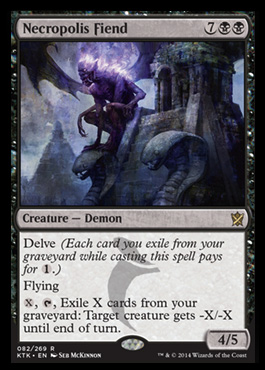
For reference, here are the five clan keywords in Khans of Tarkir:
Sultai (BUG) – Delve
Temur (RUG) – Ferocity (Get paid for having creatures with four or more power.)
Jeskai (UWR) – Prowess (When you cast a non-creature spell, this creature gets +1/+1 until end of turn.)
Mardu (WRB) – Raid (When this enters the battlefield, if you attacked this turn, get paid.)
Abzan (WBG) – Outlast (Cost, T: Put a +1/+1 counter on this, which is great because this clan has lots of rewards for +1/+1 counters.)
Morph is also in the set but spread among all five colors. That’s a lot of mechanics, but I’m kind of okay with that, particularly since most of them
aren’t exactly mindblowingly different than past mechanics.
As for the Sultai, there’s no question, it’s going to be good day one and likely in multiple forms. I think the likely path we’ll want to take is looking
at what sweet gold cards are printed (as well as any possible busted mythics), look to see if those fit, and then build around them. For instance, take a
look at Sultai Charm:
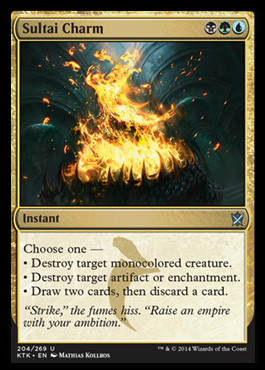
Charms have always been popular cycles, and the gold ones have pretty classically excelled at showing up in Constructed. Sultai Charm seems pretty destined
to succeed by giving us:
Catalog may not seem that exciting compared to Ultimate Price and Naturalize, but remember it’s a three-cost spell. If it cost 1U and was still an instant,
people would go crazy over it. Sultai Charm does cost three, not two, but all three of its modes are very useful and are well worth paying extra for in the
right circumstances. It’s definitely the type of card that we might only want a few of if we want it to primarily be a removal spell; however, I could see
it turning out incredible because of the card draw side.
Esper Charm was the greatest of all the Shards Block charms because of its ability to draw two, and while this isn’t quite that, it’s not that far
off. Esper Charm could destroy enchantments, which Sultai Charm can also do, but it also hits artifacts. Besides, there are a lot more
enchantments running around than there were back then. Finally, making your opponent discard two cards is great, no question, but the ability to Ultimate
Price a Stormbreath Dragon or Polukranos is a very serious new dimension to the utility of Sultai Charm. This one is an easy hit in my opinion. The
interesting puzzle will be seeing how people balance the desire to play Sultai Charms and the desire to play Hero’s Downfalls (which is to say nothing of
Silence the Believers).
It’s hard to build realistic decks until more of the set is revealed, but here’s a possible sketch just based on current information:
Sultai Midrange by Patrick Chapin
4 Three-Color Gold Creature
4 Sultai Tri-land
3 Swamp
2 Island
1 Forest
The other two green clans are going to have manabases that are set up a little different. Let’s take a look at the more obvious of the two, Abzan. The
Abzan clan was another of the three pillars of Theros Block Constructed and would be popular even if there were zero gold cards for it. And let’s be
serious, there are going to be some sweet gold additions.
Abzan Midrange Manabase:
4 Abzan Tri-land
5 Forest
2 Plains
While this manabase would play into a lot of Sylvan Caryatid/Courser of Kruphix decks, what if we want a more Fleecemane Lion into Brimaz sort of deck,
backed up with Hero’s Downfalls?
Abzan Aggro Manabase:
4 Abzan Tri-land
3 Forest
3 Plains
If we end up needing Hero’s Downfall, we might want another black source or two, perhaps trimming a Forest and a Windswept Heath. On the other hand, if
Abzan Charm turns out to be a good removal spell, maybe we don’t need Hero’s Downfall. My guess is that Gild is more likely to end up in a ramp deck than
an aggro deck, but it is worth keeping in mind, as it is hard removal with only a single black in its cost. We also need to ask ourselves if we need our
lands to be untapped on turn 1 since we could easily want to replace a bunch of these enemy painlands with Temples.
Nissa, Worldwaker may have to compete with Ajani, Mentor of Heroes, but I think it’s probably better in Abzan than Sultai because of the ability to keep
fetching up basic Forests with our fetchlands as the game goes on. Making 4/4 trample, haste creatures is great but so is untapping a bunch of lands!
The other green clan, Temur, could potentially make use of Nissa as well, but now she has to compete with Sarkhan, the Dragonspeaker. How good is Sarkhan?
Well, that’s a large enough topic to save for a day dedicated to him. My gut first reaction is that Sarkhan looks really strong. He’s sort of a combination
of Koth of the Hammer and Flametongue Kavu. The ability to send four in the air with haste is such a powerful offensive weapon, and it really puts someone
on a short clock before his ultimate is online. Then, on the other side, he is going to function as a Flametongue Kavu against creature decks, most notably
smashing the hell out of Courser of Kruphix.
Sarkhan, the Dragonspeaker. Format-defining bomb.
We’ve been mainly focused on Courser manabases, as that provides a ready-made context. Until we know what Jeskai and Mardu decks look like, it’s hard to
know what their demands will be, manawise. That said, here’s a first attempt at each:
Jeskai Manabase:
4 Island
3 Plains
This is basically a U/W Control deck that splashes red pretty easily, however, I could totally imagine Jeskai taking on a much more aggro-control feel.
Prowess already sort of lends itself to a tempo-based gameplan, and red removal could be great against the format if it starts out fast to take advantage
of the untapped duals and pain everyone is inflicting on themselves.
Mardu Aggro Manabase:
3 Swamp
3 Mountain
This one is set up to be a B/R Aggro deck that splashes white for a couple of sick gold cards. If we decide to end up being more Brimaz oriented, we are
probably going to have to cut down on Bloodstained Mire, which makes it hard to support double white cards on a low land count.
Mardu Brimaz Aggro Manabase:
2 Swamp
1 Mountain
1 Plains
This one obviously uses more tapped lands but can support both Brimaz and Hero’s Downfall, in addition to having red mana for sweet gold cards.
One last manabase I’d like to take a look at today is that of the light splash. For instance:
Green/x Manabase:
6 Forest
1 Mountain
1 Plains
This might be a manabase found in a Green Devotion deck that wants to reliably have as much green as possible but supports both red and white splashes off
of fetchlands, Mana Confluence, and Sylvan Caryatid. Playing lots of one basic and just one of another (or possibly two) is a great way to do things like
splash black removal in a red aggro deck or make it possible to cast Xenagos in your Red Devotion deck.
As should be pretty clear, fetchlands are going to have a dramatic impact on the sorts of decks we can build in standard. It’s fascinating. Looking at the
asymmetry of the different color combinations and figuring out how to balance power and consistency is going to be a real challenge in the months to come.
Particularly since there are more cycles of lands to come…


